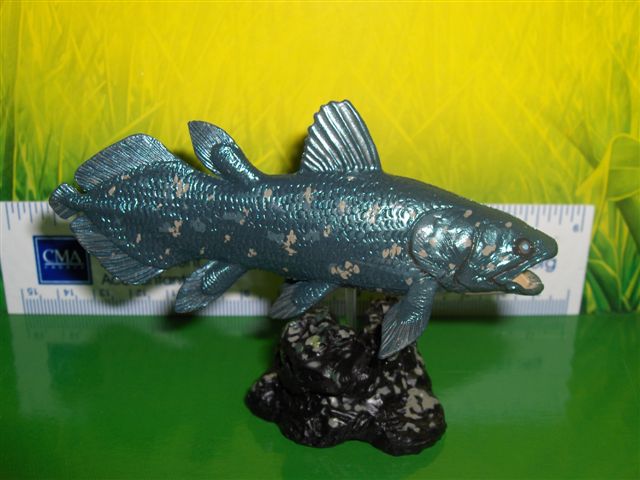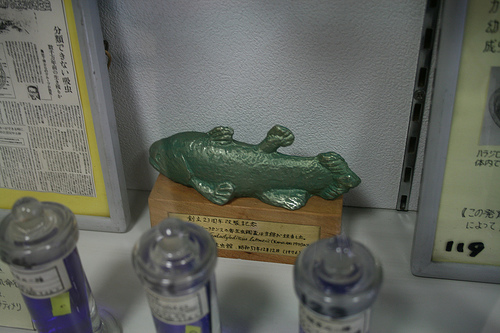
Indonesian coelacanth (Latimeria menadoensis) replica, Colorata. Photo by Brent Swancer, used by permission.
August 14, 2009
You never can tell what you might stumble across at your local neighborhood aquarium gift store. Brent Swancer has informed me of the discovery of a robust Japanese replica of the Indonesian species of coelacanth (Latimeria menadoensis). He found it during an excursion out with the family.

Indonesian coelacanth (Latimeria menadoensis) replica, Colorata. Photo by Brent Swancer, used by permission.
Unlike the 14cm long coelacanth figurine (below) in the “fossil fish” boxed set from Colorata, the unique, apparently limited release Indonesian species figurines (above) are slightly larger coelacanth replicas with the species-specific markings for Latimeria menadoensis.

African coelacanth (Latimeria chalumnae) replica, Colorata. Photo by SBell, used by permission.
The coloration on these replicas appear to be based on the Japanese video specimen. The Japanese team that filmed the Indonesian coelacanth off Sulawesi island claimed that it looked bluish, with glowing green eyes. The dark, green/blue coloration of this model agrees with what is known of the Sulawesian specimen, down to the spot pattern on the replicas.

A capture of an image from the Japanese research team videotape of a one-meter long coelacanth at a depth of 170 m, 17, at 8:30 am on May 30, 2006, off shore Buol, about 350 km west from Manado, Sulawesi Island, with a ROV operated by the Aquamarine Fukushima Survey team. This town is only a few miles (east) from where the Jago team saw two coelacanths in a cave near ToliToli.

Indonesian coelacanth (Latimeria menadoensis) replica, Colorata. Photo by Brent Swancer, used by permission.

Above: The first Indonesian coelacanth captured by locals, on behalf of scientists Mark and Arnaz Mehta Erdmann, who described the discovery in the September 24, 1998 issue of Nature. Photo courtesy of the Erdmanns.
The African coelacanth has the species name Latimeria chalunnae. The Indonesian species, which was at first allegedly said to be brown, has gold flecks on its sides, and was offically named Latimeria menadoensis by French scientists who described it before Mark Erdmann was able to officially. Several pages in Cryptozoology A to Z discuss the differences and significance between the two stories of these darlings of cryptozoology, but also note that Mark Erdmann has his doubts about the two different species. The Japanese video may have proven he is correct.
The color of the filmed Indonesian coelacanth is not brown: "The camera light caused the fish’s eyes to glow green. It was there. Its body was dark blue," the research team reported to museum director Yoshitaka Abe. That’s "dark blue" or “blue-black” (ao-guroi in Japanese). This finding, that there is one species worldwide with different colorations, as opposed to a different brown species in Indonesian waters, would be intriguing news, if verified further.
What we do know, in the world of replicas now too, Brent Swancer has discovered there is a very unique Indonesian coelacanth that has been made and perhaps is found in only one aquarium location in Japan! I thank him for obtaining this rare item for the cryptozoology museum.

If you were not confused enough, directly above is S. Bell’s photo of Kaiyodo Aquatales Deepsea coelacanth (obviously African?), which is very small. (I have one of those now on the mantle under the 5.5 ft long fiberglass replica of a coelacanth seen below, in the background.)

Photo by Amber Waterman, used by permission.
Still unidentified is the following coelacanth replica seen in an African museum.

Your contributions, like Brent Swancer’s, to the collection are always welcome, and you may send donations of artifacts, souvenirs, and other objects or funding directly to the International Cryptozoology Museum at PO Box 360, Portland, ME 04112 USA. (Donations sent to the “Cryptomundo” button above do not reach the museum or Loren Coleman, who is not an administrator, nor the founder-owner of Cryptomundo.) Help to keep the museum open via clicking on the following button, which has space for a private message:
🙂 Thank You.
About Loren Coleman
Loren Coleman is one of the world’s leading cryptozoologists, some say “the” leading living cryptozoologist. Certainly, he is acknowledged as the current living American researcher and writer who has most popularized cryptozoology in the late 20th and early 21st centuries.
Starting his fieldwork and investigations in 1960, after traveling and trekking extensively in pursuit of cryptozoological mysteries, Coleman began writing to share his experiences in 1969. An honorary member of Ivan T. Sanderson’s Society for the Investigation of the Unexplained in the 1970s, Coleman has been bestowed with similar honorary memberships of the North Idaho College Cryptozoology Club in 1983, and in subsequent years, that of the British Columbia Scientific Cryptozoology Club, CryptoSafari International, and other international organizations. He was also a Life Member and Benefactor of the International Society of Cryptozoology (now-defunct).
Loren Coleman’s daily blog, as a member of the Cryptomundo Team, served as an ongoing avenue of communication for the ever-growing body of cryptozoo news from 2005 through 2013. He returned as an infrequent contributor beginning Halloween week of 2015.
Coleman is the founder in 2003, and current director of the International Cryptozoology Museum in Portland, Maine.
Filed under Cryptomundo Exclusive, Cryptotourism, CryptoZoo News, Living Fossils, Replica Cryptia